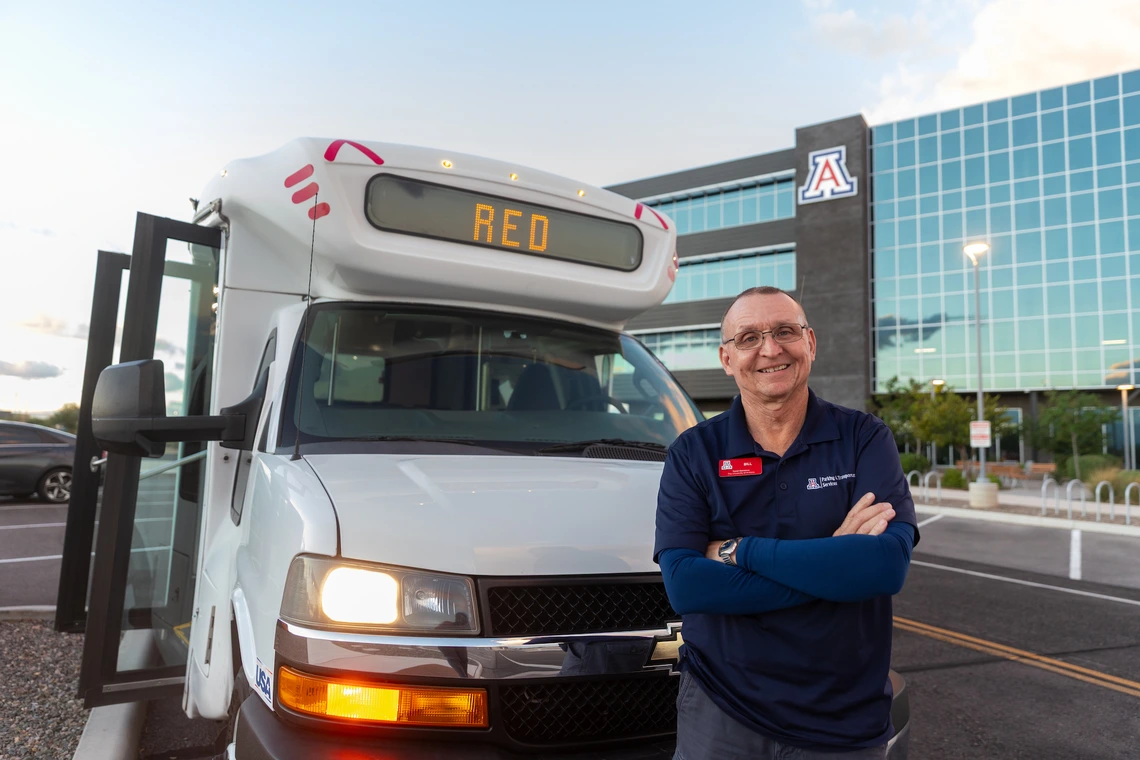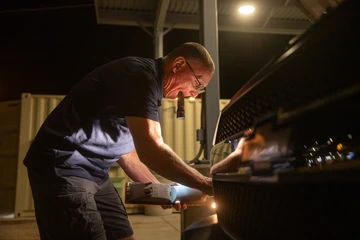'It's a service': Riders or not, this Cat Tran driver will be there at 3:55 a.m.

Bill Mason has been driving Cat Tran for 11 years – and he's spent the last two driving the campus transit service's red route, which starts at 3:55 a.m. "It's a service," he said. "And I always know eventually I'll have riders."
Kyle Mittan/University Communications
This article is the first in an occasional series in Lo Que Pasa that highlights U of A employees who work outside traditional daytime hours. Think we should feature someone you work with? Email Kyle Mittan at mittank@arizona.edu.
Bill Mason's most recent Friday-morning shift began as most shifts do: at about 3 a.m., shrouded in darkness, his head under the hood of a Cat Tran bus.
He checked all of bus #8566's vitals – oil, transmission fluid, power steering fluid, serpentine belts, and a host of other details – before noticing that the front passenger turn signal bulb had blown. So, he replaced that, too, before moving onto the tires.
"There's a lot of stuff that I do that I don't even think about, I just do it," Mason said chipperly while the engine idled, his comment alluding to the manners and habits that come with four decades of driving commercial vehicles – including 11 years driving Cat Tran.

Mason's day on Friday began at about 3 a.m., and included replacing a blown turn-signal bulb during his pre-trip inspection.
Kyle Mittan/University Communications
All that experience makes Mason a clear fit to be the first driver to ready the bus each morning for the next 16 hours it will spend driving employees and students to campus. Mason has driven the Cat Train's red route – the earliest route in Parking and Transportation Services' free campus transit program – since the route began running in 2023.
With a start time of 3:55 a.m. every day that classes are in session, the park-and-ride line takes students and employees about four miles to campus from their cars parked at the university's Tech Park at The Bridges. The route runs until 7:30 p.m.; buses on the route log about 220 miles a day.
Mason completed his pre-trip vehicle inspection on the bus and set out toward The Bridges at about 3:40 a.m., slinking the bus out of Cat Tran's operations center on Sixth Street, then turning south on Campbell Avenue. At that hour, Kino Parkway was deserted.
Since it was a Friday, Mason said, the bus stops would likely be sparse, as well.
"It's a service," Mason said matter-of-factly. "Our hours are posted and you're here to do what you've got to do – it's just the nature of the beast. And I always know eventually I'll have riders."
Mason likes the driving, sure, but it's his interactions with the riders that keep him working the 3-11 a.m. shift, which requires going to bed at 6 p.m. and waking up at 2 a.m.
As an Air Force veteran who never attended college, Mason said he especially enjoys hearing from students about the college experience he never had.
"A lot of them are what I call babies – they're so young, they have a path, they know what they want to do and how they want to get there," said Mason, a father of three daughters who are now all adults. "It's good to learn what their dreams are and what they want to do, because I never had the opportunity to go to college."
Mason did eventually have riders on Friday, just before sunrise at 6 a.m.
Sandy Bergman, a culinary and food services attendant who works at the Cactus Grill in the Student Union Memorial Center, said Mason was the first driver she became friendly with. She recalled how, one day, she misplaced her keys on the bus. Mason found them, immediately knew whose they were, and phoned a Cat Tran supervisor to help get them returned.
"I was really impressed," Bergman said.

Sandy Bergman, a culinary and food services attendant at the student union, gives Mason a fist-bump as she gets off at her stop. "If I was able to choose, he'd be my driver every time," she said.
Kyle Mittan/University Communications
"If I was able to choose, he'd be my driver every time," she added. "You could have a bad day, then come talk to him – it's nice."
Mason, who overheard Bergman's comments from the driver seat, flashed a warm smile at her into his rearview mirror. "Thanks, Sandy – back at you," he said.
Jesús Tapia, a first-year engineering student who boarded with Bergman, said he began riding the red route when he started his program in August, a convenience he appreciates to avoid the traffic on Kino. And like Bergman, Tapia has also seen Mason go the extra mile for passengers.
"I like how he goes out of his way to talk to all the individual people on the bus," Tapia said.
Tapia recalled an occasion when he saw Mason notice an unfamiliar rider board the bus with headphones on. Mason, Tapia said, took the initiative to tell her she had boarded the red route and would be taken off campus – which was not what she wanted. Because of Mason, she had time to find the right bus.
"It's just nice to see that people care about you," Tapia added.
Mason dropped off Bergman and Tapia at Graham-Greenlee dorm before rolling past the north side of Arizona Stadium and stopping outside Meinel Optical Sciences for the timed stop at the end of his route. Campus was slowly coming to life as the Mall welcomed its morning rush of exercisers.
Mason smiled and waved to a pair of "walking buddies," as he called them, who smiled and waved back. (Mason quickly clarified that he does not walk with his walking buddies, simply waves to them from the bus.)
Those small connections are reminders that Mason's early-morning rituals – the 3 a.m. start time, the bus maintenance checks, all of it – are done with service to the campus community in mind.
"It's my little portion," Mason said. "But I enjoy doing it."

